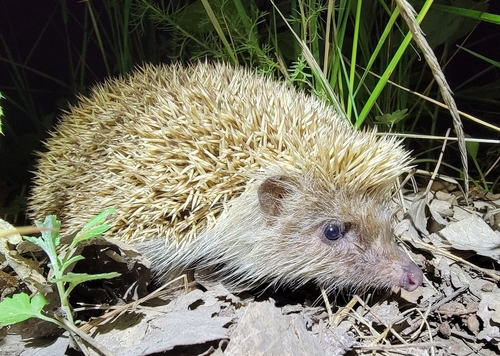If you cannot find the answer you are looking for, please contact us.
Hugh’s hedgehog

First described in 1908 by Thomas. It is found in northern China and parts of Mongolia and is well adapted to both open grassland and scrubland. It has a relatively light facial colour compared to other Mesechinus species.
Taxonomy
| Kingdom: | Animalia |
| Phylum: | Chordata |
| Class: | Mammalia |
| Order: | Eulipotyphla |
| Family: | Erinaceidae |
| Genus: | Mesechinus |
| Species: | Mesechinus hughi |
Natural range & habitat
Hugh’s Hedgehog occurs in northern and central China and parts of Mongolia, where it inhabits a variety of temperate environments. It is found in open grasslands, scrublands, agricultural edges, and sparsely wooded areas, and it is known to tolerate moderately disturbed habitats provided there is adequate cover and prey availability. In some regions, it can also be found along the edges of villages or in cultivated fields, though its preference remains for semi-natural landscapes. The species generally avoids dense forest and high-altitude environments, although it has been recorded in upland steppe zones. Seasonal changes in temperature and precipitation influence activity and foraging, and it favors soils that allow for easy digging.
Physical traits
Hugh’s Hedgehog is a medium-sized hedgehog with an average length of around 20 to 25 centimeters and a weight ranging from 600 grams in spring to over 1 kilogram before hibernation. The dorsal spines are banded brown and cream, while the underparts are covered in coarse, brownish-grey fur. The face is typically lighter in color, with small rounded ears that sit close to the head. It has a sturdy build with relatively short legs adapted for digging and foraging. As with many temperate hedgehogs, seasonal fat accumulation is pronounced in preparation for hibernation. There is little sexual dimorphism, although males can be slightly heavier during the breeding season.
Behavior & lifestyle
This species is solitary and nocturnal, emerging after dusk to forage and retreating to shelter before dawn. It uses self-dug burrows, natural crevices, or dense vegetation for daytime rest and hibernation. In colder climates within its range, it undergoes a true hibernation from late autumn until spring, depending on local temperatures. Before hibernation, it constructs a well-insulated nest, often in an underground chamber lined with dry plant material. It is an active forager and may travel considerable distances each night in search of food. Encounters between individuals outside of the breeding season are rare and often involve avoidance behaviors or mild aggression.
Communication
Communication in Hugh’s Hedgehog is primarily olfactory, with scent marking used for territory establishment and reproductive signaling. Acoustic signals include huffing, grunting, and hissing, especially during courtship or in defensive situations. Like other hedgehogs, it engages in self-anointing behavior after encountering strong or novel scents, though the function of this behavior is not fully understood. Vision plays a minimal role in communication, with smell and hearing being the dominant senses for detecting food, predators, and conspecifics.
Diet in the wild
Hugh’s Hedgehog is an opportunistic insectivore and omnivore. Its diet consists primarily of ground-dwelling invertebrates such as beetles, caterpillars, earthworms, and grasshoppers, supplemented by occasional small vertebrates, bird eggs, and carrion. Seasonal fruits or berries may be consumed when available, though plant matter forms only a small portion of the diet. Foraging is mostly done on the ground, involving sniffing and digging to uncover hidden prey. The species obtains most of its water from food sources, but will drink from standing water when available.
Reproduction & life cycle
The breeding season occurs in spring and early summer, shortly after emergence from hibernation. Courtship involves circling behavior accompanied by vocalizations and scent-based interactions. Gestation lasts approximately 35 to 40 days, after which the female gives birth to a litter of typically three to six hoglets in a concealed nest. The young are born blind and with soft spines, which harden within the first few days. Eyes open at around two weeks of age, and weaning occurs by four to six weeks. Juveniles disperse soon after weaning, and those born late in the season must grow rapidly to prepare for hibernation. Sexual maturity is generally reached within the first year. Lifespan in the wild is thought to be around three to five years, though precise data are lacking.
Threats & conservation status
Hugh’s Hedgehog is currently listed as Least Concern by the IUCN, with a relatively wide range and no major population declines reported. Local threats include habitat loss from agricultural expansion, infrastructure development, and urbanization. Road mortality and predation by domestic dogs may impact populations near human settlements. The use of pesticides in agricultural areas may indirectly affect the species by reducing prey availability and causing secondary poisoning. Climate change could alter hibernation cycles and prey abundance, but these effects have not been studied in detail. The species benefits from its adaptability to a range of open habitats, which contributes to its overall stability.
This species in captivity
Hugh’s Hedgehog is not common in captivity and is rarely found outside its native range. It may be kept temporarily in wildlife rescue centers or research institutions, but it is not part of the exotic pet trade. Its long hibernation period, strong digging instincts, and specific environmental requirements make it poorly suited for typical pet care. When kept in captivity, it requires a large, enriched enclosure with opportunities for digging and nesting, and a diet that replicates its natural insect-rich feeding habits. Seasonal temperature cycles must be maintained to allow for proper hibernation in colder climates. There are no established captive breeding programs, and conservation efforts for this species focus on habitat protection and reducing threats in the wild.
